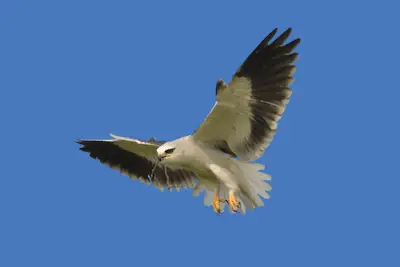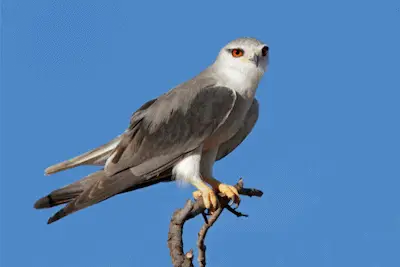Black-shouldered Kite
(Elanus caerulus)
The Black-shouldered Kite is the most recent addition to the list of raptor species in Europe, having first started breeding in Spain in the 1970’s, and later in Portugal and Southern France.

The fact that the European population of Black shouldered Kites is now thought to number more than a 1000 pairs is an exciting success story of a raptor that has expanded its breeding range in recent years.
The Black shouldered Kite is a very elegant small raptor that can be observed hunting for rodents from a perch, or on the wing.
If you can get close enough, the piercing ruby red eyes combined with its light grey and white plumage form a very striking image.
Black shouldered Kite facts
A very elegant small raptor, the Black shouldered Kite is most often seen perched on a dead tree or a telephone pole, where it patiently waits for prey to appear on the ground below.
Black-shouldered Kite size
Black-shouldered Kites are small European raptors, and in overall size and shape resemble a small Falcon species.
- Wingspan: 75-89 cm
- Length: 30-35 cm
- Weight: 195-345 g
The Black-shouldered Kite is similar in size to the Eurasion Kestrel, although it has a slightly larger wingspan and weight. It can be easily distinguished from a Kestrel due to its grey/white coloring and the shorter tail.
Appearance
One of the most distinctive features of the Black shouldered Kite are its light grey and white coloring, combined with its piercing red eyes.

The Black shouldered Kite is a small raptor, and resembles a falcon species in many ways, including in its ability to hover over the ground while pointed into the wind, as it waits for its prey to appear below. The falcon-like appearance of the Black shouldered Kite is further enhanced by its pointed wings and short tail.
Sexual dimorphism
There is no known difference between the two sexes of the Black-shouldered Kite. There are thought to be up to 4 different subspecies, of which only one occurs in Europe.
Scientific name and taxonomy
The scientific name of the Black-shouldered Kite is Elanus caerulus. It is thought that there are up to 4 subspecies, but only one of these is present in Europe.
Black shouldered Kite distribution
The European population of the Black shouldered Kite only breeds in Portugal, Spain, and Southern France. Interestingly, the Black shouldered Kite only recently started breeding in Europe, with the first reports of successful breeding pairs in the 1970’s in Spain, and in the 1990’s in Southern France. Spain currently has the largest population of Black-shouldered Kites, with up to 1000 breeding pairs.
Black-shouldered Kite habitat
The Black-shouldered Kite favors open, arid country, and in Africa is found predominantly in the Savannah. In Europe it lives in and around open pastures, grassland, and shrubland. It avoids large forests.
Black shouldered Kite population size
The Black shouldered Kite population size is estimated to be between 600 and 1200 breeding pairs. While this is a relatively small number, it should be noted that it has increased dramatically since the 1970s, when the first pairs were observed in Spain.
Black shouldered Kite behavior
The most common behavior of Black shouldered Kites is to sit on exposed perches, such as dead trees or telephone poles, where they wait for suitable prey to come out in the open.
Feeding and diet
Black-shouldered Kites predominantly feed on small rodents, and secondarily also hunt insects and reptiles, and on occasion also small birds. Almost all prey is taken on the ground. Similar to the Eurasian Kestrel, it sometimes hunts by hovering and then stooping down on its prey. However, this behavior is much less common than sitting on a perch, since it requires a lot more energy.
Breeding
European Black shouldered Kites lay their eggs in early spring (in February to April), and on average they lay 3 to 4 eggs that are incubated for 31 to 34 days, after which the young spend up to 35 days in the nest.
In some cases, a female Black shouldered Kite will start a second brood with a different male, while the first male continues feeding the young fledgelings from the first brood.
Migration
The European population of Black-shouldered Kites is sedentary, although movements sometimes occur in response to changes in food availability.
Black-shouldered Kite conservation status
The IUCN conservation status for the Black-shouldere Kite is of “Least Concern”, due to the fact that its population has steadily increased since it started breeding in Europe in the 1970’s.
However, given that the total number of Black-shouldered Kites is still relatively small in Europe, this small European kite species is potentially vulnerable to changes in its habitat.
Threats
The main threats to Black shouldered Kites are pesticides, as well as changes to their habitat.
Similar to other raptor species, the Black shouldered Kite doesn’t thrive in areas with highly intensive agriculture, which tends to destroy hedgerows and and other marginal zones required for rodents and other small animals.
